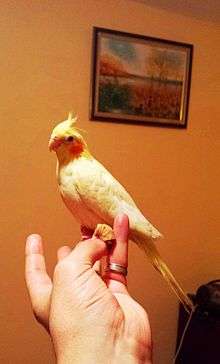Lutino cockatiel
| Lutino cockatiel | |
|---|---|
 | |
| Scientific classification | |
| Kingdom: | Animalia |
| Phylum: | Chordata |
| Class: | Aves |
| Order: | Psittaciformes |
| Superfamily: | Cacatuoidea |
| Family: | Cacatuidae |
| Subfamily: | Nymphicinae |
| Genus: | Nymphicus |
| Species: | N. hollandicus |
| Binomial name | |
| Nymphicus hollandicus | |
The Lutino cockatiel is one of the most popular mutations of cockatiel, with a mostly white to light-yellow feathers and orange cheek patches.
The "normal grey" or "wild type" of a cockatiel's plumage is primarily grey with prominent white flashes on the outer edges of each wing.
However, bird breeders can breed for certain traits, and they have been breeding for different color mutations in cockatiels since the 1940s.[1]
The Lutino cockatiel mutation was the second cockatiel mutation to be established in usa, after the first being the Pied cockatiel mutation in 1951.[2]
The Lutino appeared in the aviaries of Mr. Cliff Barringer of Miami, Florida, United States, in 1958.[3] [4]
Sound and appearance
All cockatiel colour genetic mutations have the same calls. The male Lutino cockatiels can talk, sing, and dance (shakes head, makes the wings heart shape, etc) to attract female cockatiels. Lutino cockatiels appear as full body in color yellow with two orange circular spots around the ear and cheek area.

.jpg) Male Lutino cockatiel
Male Lutino cockatiel Daisy Lutino Cockatiel
Daisy Lutino Cockatiel Lutino Cockatiel
Lutino Cockatiel
See also
References
External links
| Wikispecies has information related to: Nymphicus hollandicus |
- Cockatiels - National Cockatiel Society
- Cockatiel Information Forum and Bulletin Board - Talk Cockatiels
- Videos, images and sounds - Internet Bird Collection